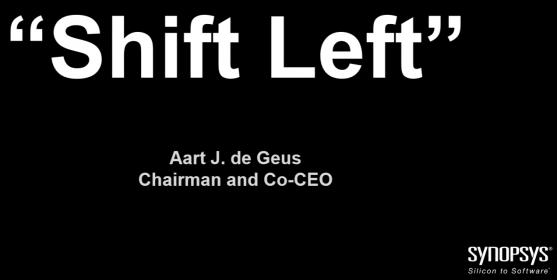In the traditional sense “Shift Left” is the process of making things simpler in an effort to make things faster. Shift Left was the theme of theDVCon keynote last week delivered by Synopsys co-founder and co-CEO Aart de Geus which is right on topic when it comes to modern semiconductor design and manufacturing, absolutely.

KEYNOTE: Smart Design from Silicon to Software
In our current semiconductor design community, the word “change” is, to say the least, an understatement. From a dizzying array of emerging “smart” niche end-products to major market trend shifts to ecosystem reconfigurations at every level, the world around us is morphing at an unprecedented pace. The challenge for IC designers to keep pace has never been greater. The good news is that we’re up for it! In his presentation, Aart will address the business and technology trends that are stretching designers’ concerns beyond the traditional sand boxes of design and verification.
First you should know that more than 1,200 semiconductor professionals participated in this event which is an all-time high. I was there, it was packed, I ran out of business cards yet again. Synopsys put out a nice lunch with great speakers from Freescale and Xilinx but Aart stole the show of course and he stayed afterwards for questions which is nice.
The premise of Aart’s keynote is that design schedules are not really changing but more work is being done within the same schedules. The big change I have seen is what I call the “Apple Effect”. In order to get a bite of the billions of dollars of Apple semiconductor ecosystem business you must synchronize your product schedules to the yearly iPhone release date which is just in time for the holiday shopping season.
The entire fabless semiconductor ecosystem pretty much accommodates Apple now including chip companies, foundries, IP providers, and even EDA companies. I welcome this added discipline (no more slipping product schedules) but the added pressure is seriously stressing the ecosystem. What does not kill us makes us stronger, right?
The point of Aart’s keynote that resonated strongest with me, along with IP re-use, was the requirement of eliminating point tools to shift your design schedule left: “In order to shift left you must have predictability through a highly connected design flow”.This is something I have heard since the beginning of big EDA but it has yet to come true. That is of course before multi-patterning, FinFETs, full coloring, and who knows what other design horrors 10nm and 7nm will bring us. Well, I have a pretty good idea but that is another discussion all together. The bottom line is that synthesis must be aware of the entire “design coherent system” if you want to Shift Left in the coming process nodes.
Coincidentally, one of the most viewed wikis on SemiWiki is the EDA Mergers and Acquisitions wiki. It is a VERY long list now and as you will see Synopsys is actually many different point tool technologies (400 million lines of code according to Aart) integrated into a seamless synthesis driven flow. It will be interesting to see what new point tool companies will be at DAC this year. They certainly are a dying breed and that makes me wonder what the future has in store for EDA. Certainly not what I had predicted in my first blog ever: EDA is Dead.
Share this post via:






Comments
0 Replies to “Shifting Chip Design Left!”
You must register or log in to view/post comments.